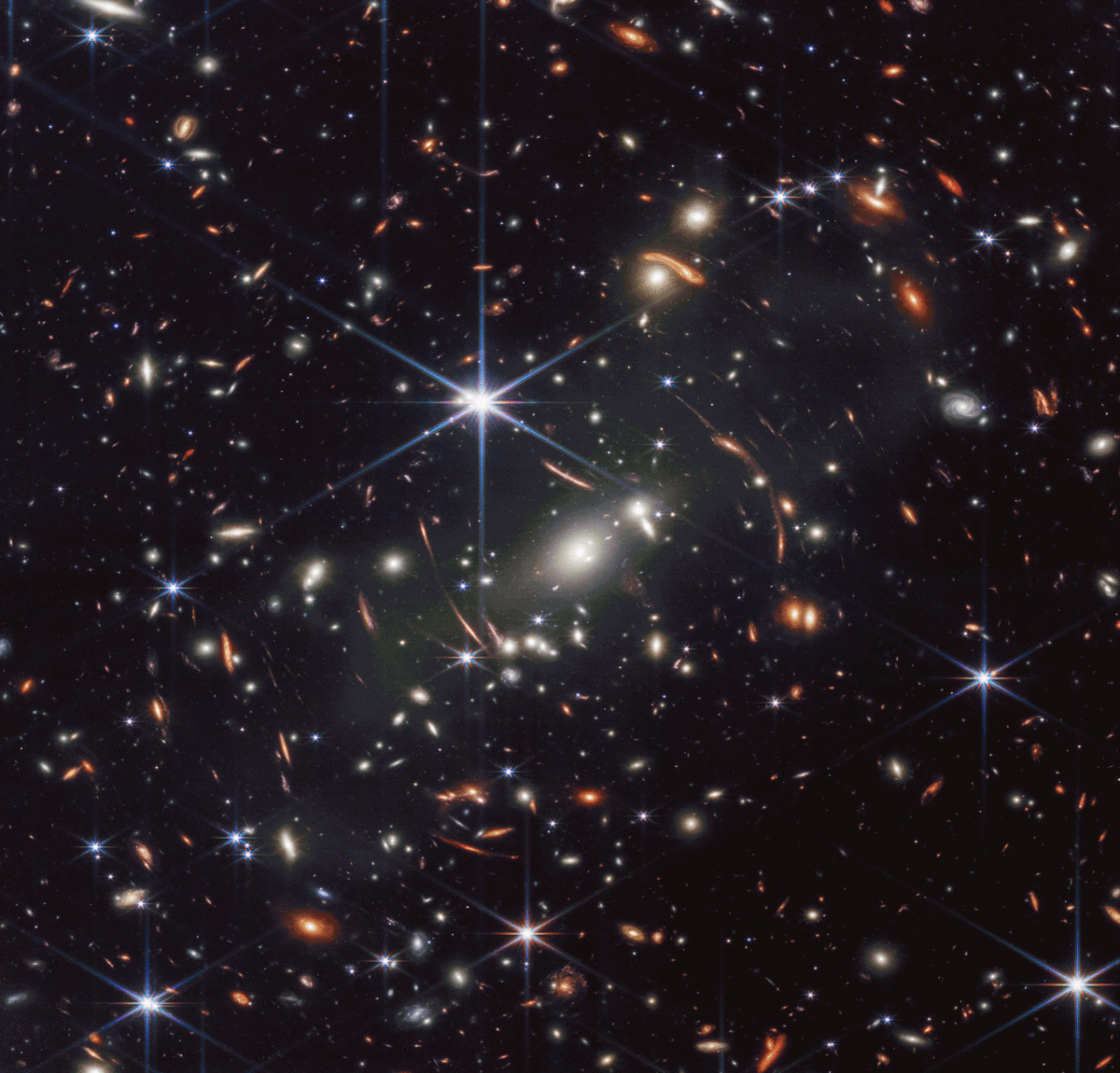Today, the James Webb Space Telescope (JWST) team shared the first science images and measurements made by the flagship spacecraft. The images showcase the deepest infrared view of our universe to date, a detailed spectrum of an exoplanet’s atmosphere, two familiar nebulae, and four galaxies in the process of colliding. Together, the images give a glimpse of the new science paradigm that the telescope will open up.
JWST, a joint mission of NASA, the European Space Agency (ESA), and the Canadian Space Agency, launched in December 2021 and has spent more than 6 months in a commissioning phase aligning its mirrors and calibrating its instruments.
Humid Alien Skies
One of JWST’s primary science objectives is to provide detailed characterization of the atmospheres of exoplanets. Its Near-Infrared Spectrograph (NIRSpec), Mid-Infrared Instrument (MIRI), and Near Infrared Imager and Slitless Spectrograph (NIRISS) instruments are ideally designed to measure subtle chemical signatures within exoplanets’ atmospheres, including potentially habitable ones. To highlight this, one of the first measurements taken was a spectrum of the atmosphere of WASP-96b using NIRISS.

“We’ve been able to use other telescopes to explore exoplanet atmospheres in the infrared, but not to this level of detail.”
“We’ve been able to use other telescopes to explore exoplanet atmospheres in the infrared, but not to this level of detail,” Knicole Colón, an exoplanet astrophysicist at NASA Goddard Space Flight Center in Greenbelt, Md., said during a 12 July media event. “What you’re seeing here is a telltale signature, the chemical fingerprint of water vapor in the atmosphere of this specific exoplanet. And the other thing we can tell is that there’s evidence of clouds and hazes because the water features are not quite as large as we predicted.”
WASP-96b is about 20% larger than and 50% of the mass of Jupiter and is about 1,000 light-years from Earth. It is a puffy gas giant that orbits its star in a mere 3.4 days and is a scorching 1012°C (1285 K). It’s a familiar character for exoplanet scientists and has been observed in the past by other space telescopes like the Transiting Exoplanet Survey Satellite (TESS) and Gaia as well as ground-based instruments. Although it is too hot to support life as we know it, this planet serves as a good testing site for the new instruments and analysis techniques that exoplanet astronomers will lean on to observe strange new worlds.
JWST’s First Deep Field
Galaxies and the universe shine brightly in the infrared, and JWST’s Near-Infrared Camera (NIRCam) captured a glimpse of it. In an image that took 12.5 hours to capture, the telescope provided the most in-depth look at the infrared universe to date.
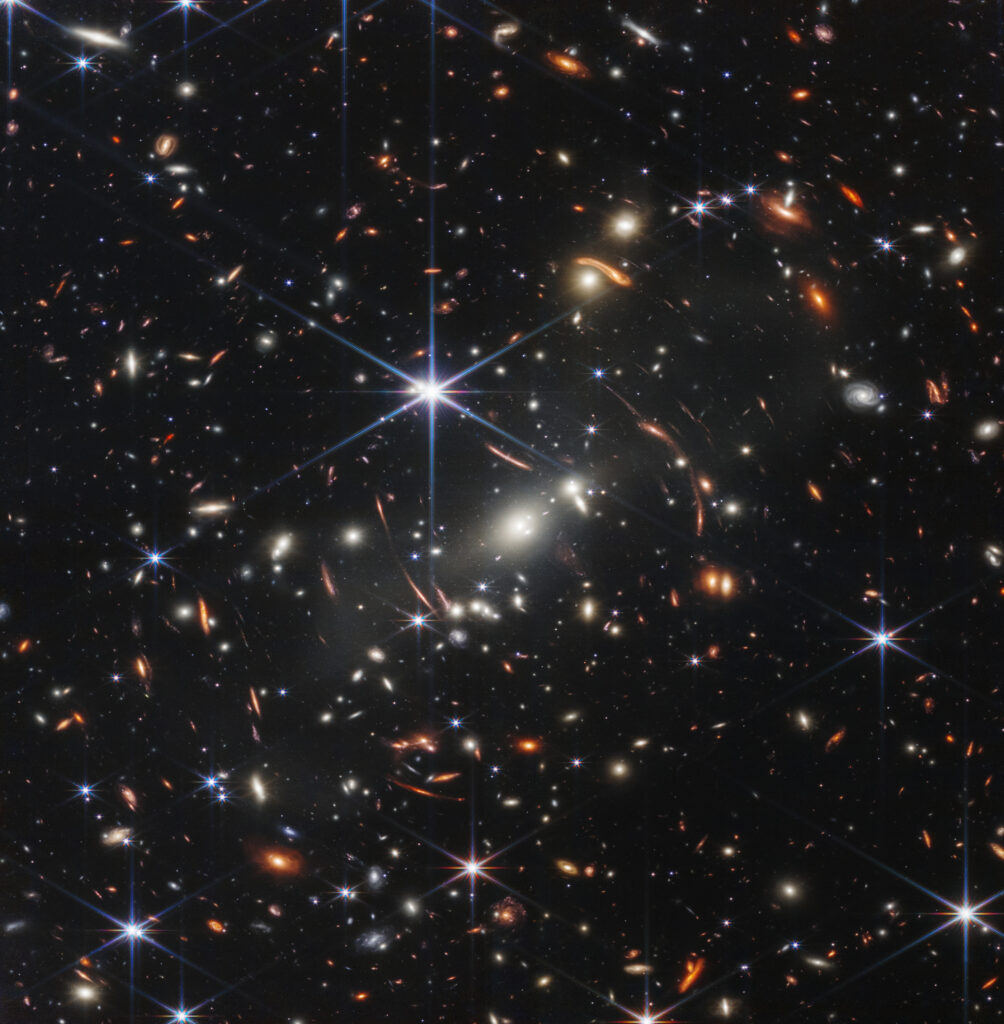
The image, released on 11 July, is of the SMACS 0723 galaxy cluster, a group of galaxies 4.6 billion light-years away. The entire image is contained within a patch of sky “approximately the size of a grain of sand held at arm’s length,” said NASA administrator Bill Nelson during an 11 July press conference.
Most of the thousands of galaxies in this image are part of the galaxy cluster, but some are much farther away—the gravity of the visible and dark matter within the cluster acts as a magnifying lens that brings into focus light from galaxies born less than a billion years after the universe came into existence (those are the arcs and misshapen blobs of light).
This image from JWST provides a deeper look into the universe than the deepest field image made by the Hubble Space Telescope, which took 2 weeks to compose.
“This is just the start of a marathon of amazing images that will reveal the deepest wonders of the universe,” Hannah Wakeford, an astronomer at the University of Bristol in the United Kingdom, said in a press release. “The first image is a minor glimpse of what is to come. Twelve and a half hours to look back over 13 billion years of time. In that image is thousands of galaxies, billions of stars and trillions of planets. How can you not be in awe?”
Unfamiliar Views of Familiar Nebulae
By observing in infrared light, JWST’s instruments are able to peer through interstellar dust that can block other wavelengths of light, allowing the telescope to see the clearest views yet of two familiar nebulae in the Milky Way: the Carina Nebula and the Southern Ring Nebula.
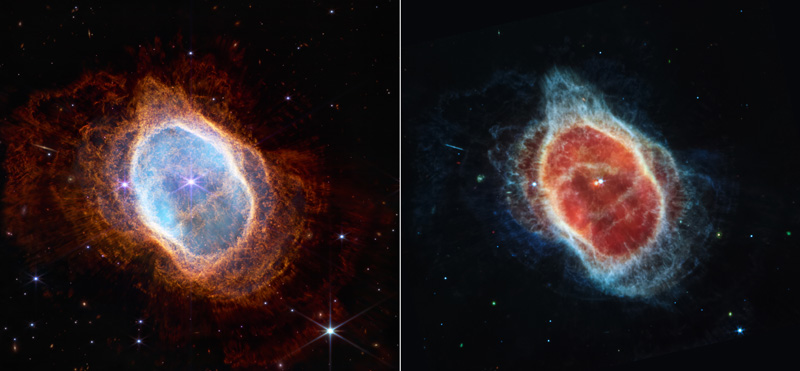
The Southern Ring Nebula, also known as the Eight-Burst Nebula or NGC 3132, is a planetary nebula about 2,500 light-years away. At the center of this nebula are two stars locked in a death spiral that release layers of gas with each orbit inward. NIRCam and MIRI were able to visually separate the two stars for the first time and also captured images of galaxies hidden behind the gas clouds.
“As we go into the center, we see a surprise for us,” said Karl Gordon, a midinfrared astronomer at the Space Telescope Science Institute in Baltimore, Md. “We knew this was a binary star, but we didn’t really see much of the actual star. But now in MIRI, this star glows red because it has dust around it. So with MIRI we got to see both stars very clearly.”
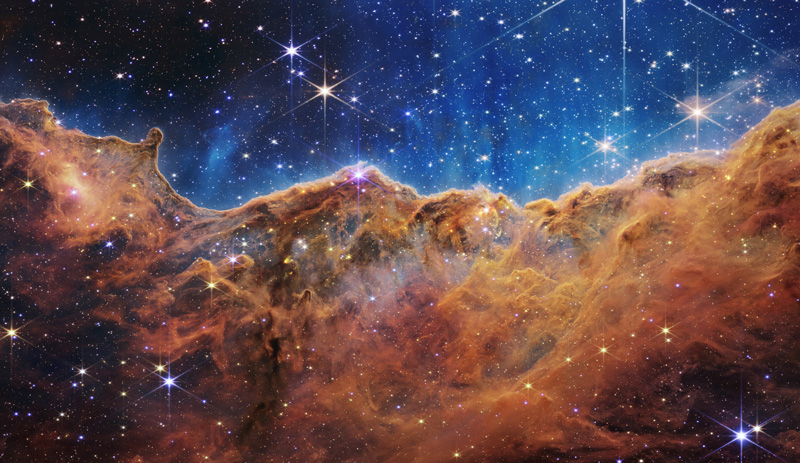
The Carina Nebula is one of the largest and brightest nebulae in the sky and is approximately 7,600 light-years away. Currently, the Carina Nebula is busy forming new stars several times larger than the Sun. In this NIRCam and MIRI image of the cosmic cliffs of Carina, hundreds of these newborn stars are seen for the first time. The view also reveals how the winds from these stars sculpt the nebula around it.
When Galaxies Collide
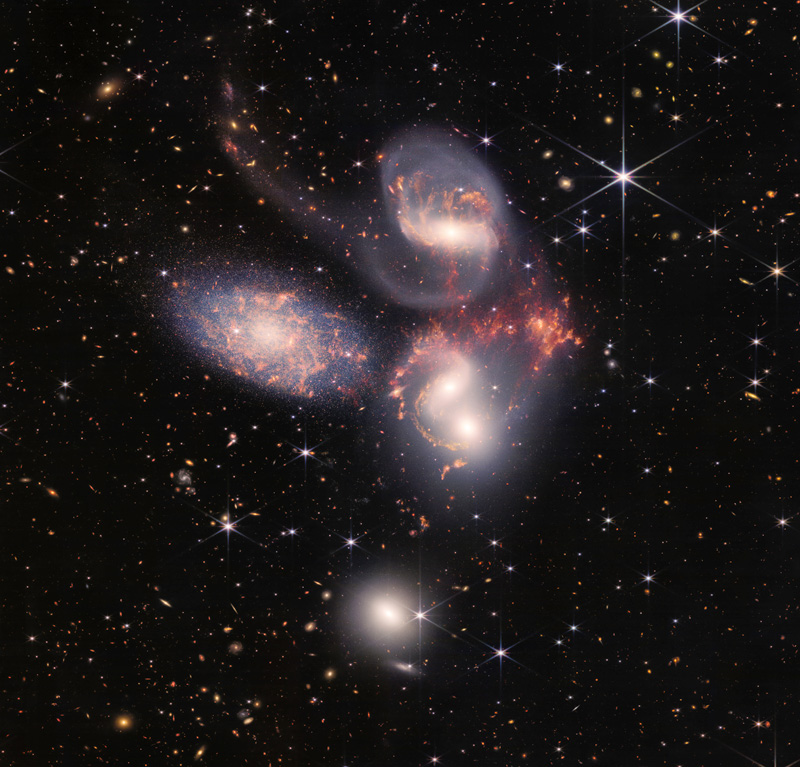
Stephan’s Quintet is a group of five galaxies about 300 million light-years away in the constellation Pegasus. Four of the five galaxies in this group gravitationally interact with each other, causing warps in their spiral structures and pulling out filaments of gas and dark matter that stretch between them. The fifth galaxy in the group is closer to Earth and only appears near to the others by a chance alignment. In addition to more precisely mapping the galaxies’ structures, MIRI, NIRCam, and NIRSpec were able to home in on the active black hole at the center of one of these galaxies.
“This is a very important image and area to study because it really shows the types of interaction that drives the evolution of galaxies, that’s the mechanism of galaxies’ growth,” said Giovanna Giardino, a NIRSpec scientist at ESA.
More Is Yet to Come
In JWST’s first year of science, it will measure the atmospheric spectra of more exoplanets, including a large survey of small, potentially rocky planets around cool stars; the TRAPPIST-1 planetary system; still-forming planets; and planets that have been eaten by dead stars.
“To borrow a phrase from a famous rock musician, we’re ready to turn this telescope up to eleven.”
There are also plans to observe solar system objects, including asteroids, Uranus, Neptune, and Pluto; active galaxies and quasars; the large-scale structure of the universe; and supernova remnants.
“It’s a culmination of decades of work, and it’s just the beginning of decades,” said Mark McCaughrean, senior adviser for science and exploration at ESA. “What we’ve seen today with these images, essentially, is that we’re ready now. This telescope is working fantastically. And to borrow a phrase from a famous rock musician, we’re ready to turn this telescope up to eleven.”
—Kimberly M. S. Cartier (@AstroKimCartier), Staff Writer

